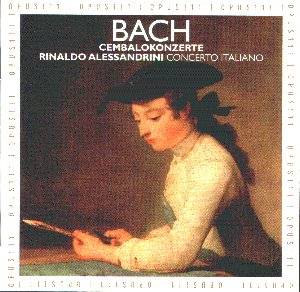Johann Sebastian BACH (1685 -1750)
Cembalokonzerte ( Harpsichord Concertos)
Concerto in D Minor BWV 1052 20'11"
Concerto in F Major BWV 1057 14'23"
Concerto in D Major BWV 1054 15'19"
Triple Concerto in A Minor for flute, violin and harpsichord
BWV 1044 21'19"
 Concerto Italiano Rinaldo
Alessandrini (harpsichord and Director)
Concerto Italiano Rinaldo
Alessandrini (harpsichord and Director)
 Recorded Rome. Feb 1996 DDD
Opus 111 OPS30 - 153 TT
71'36"
Recorded Rome. Feb 1996 DDD
Opus 111 OPS30 - 153 TT
71'36"
Crotchet
Amazon UK Amazon USA

Bach wrote six works for single harpsichord, plus others for two, three or
four instruments. Like so many composers of all periods, he was reluctant
not to extract the maximum from anything he wrote. Musically speaking, recycling
was the name of the game long before it became a fashionable thing to do
in the ecological sense. The sources of these harpsichord works can be traced
in other Bach scores, and indeed they in turn became the basis subsequently
for more writing - as for instance the D Minor Concerto (BWV 1052) which
opens the disc and which has several other versions for harpsichord.
The origins of some of the adaptations can be found in violin pieces. The
method of re-writing for the harpsichord from the violin was, following a
transposition down a tone, to allocate the violin part to the right hand,
while the left would often reinforce the bass line in the orchestra - though
Bach, master that he was, never allowed the pattern to become a rigid formula.
The three Concertos for the single soloist have the normal pattern - with
a slow middle section framed by two quicker ones. The D Minor's opening
Allegro has much of the movement's material based upon a seven-note
repeated phrase from the strings, an Adagio with a slightly ponderous
rhythm and a rollicking Finale. The source of the F Major can be found
in the 4th Brandenburg - no attempt to hide its roots, either - with
its perky opening with a prominent flute and recorder parts. Some stylish
keyboard playing in the Andante leads to a swinging Allegro
with all that lovely counterpoint. So much to listen out for! The D Major
(1054) is based on a violin concerto (BWV 1042). Its opening - sharp and
incisive, is riveting, the Adagio is allowed to drift a little, and
the final Allegro cheerful.
The CD notes spell out the Triple Concerto's origins - the outer movements
from one source, the centrepiece from an Organ sonata. Excellent soloists
on Flute and Violin - lovely tone from a 1760 instrument - are drawn from
within the Concerto Italiano. The Concerto has an especially attractive complete
middle Adagio for the three soloists unsupported and two outer movements
with a brisk opening and an unconvincingly languid close. Direction throughout
the disc is from the keyboard.
During the unaccompanied passages throughout the disc one can hear what a
fine performer at the keyboard Rinaldo Alessandrini is. The recording engineers
have - rightly - made no attempt to tinker with the balance but that means
that the harpsichord's inherent weakness lessens its audible contribution
at times.
I deliberately have used the word 'swinging' which does sum up the Concerto
Italiano's approach to the music. Not shallow and crowd pleasing swinging,
but genuinely extracting from the score what is there to be used. Perhaps
the purist may turn up the nose, but for the non-specialist this approach
is welcome. This is a period instrument ensemble, and a listing of the
instruments used is in the CD notes.
A pleasant disc that I enjoyed though with reservations. Perhaps one to hear
before buying.
Reviewer
Harry Downey

